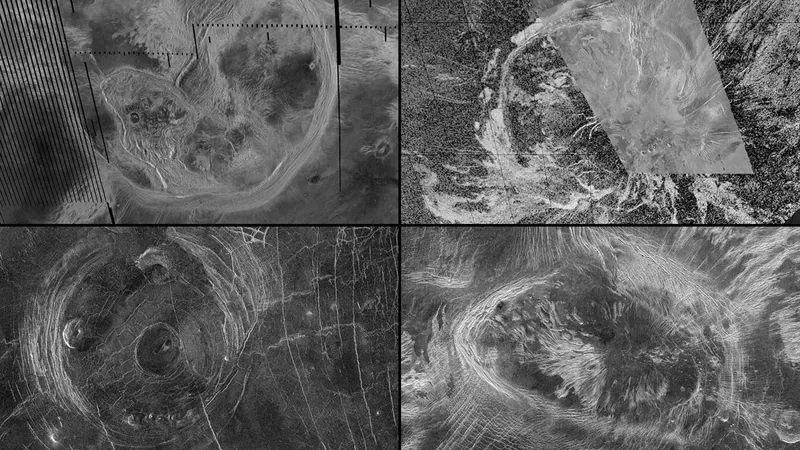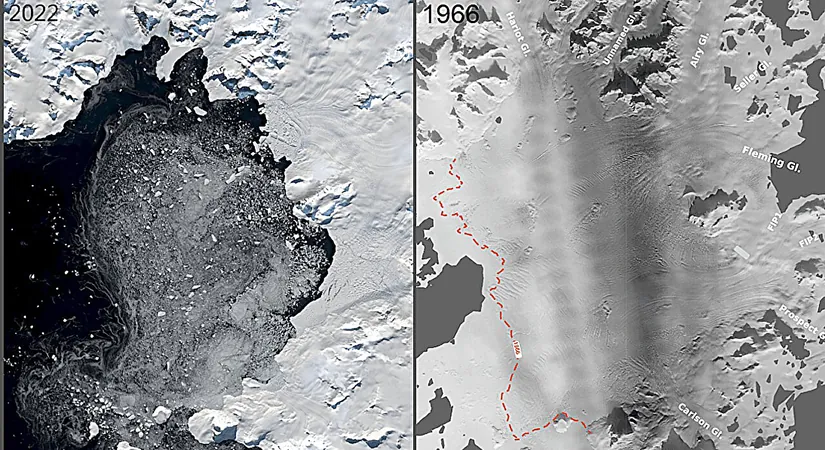
Mysterious Circles on Venus Hint at Ongoing Geological Activity!
2025-05-19
Author: Amelia
Venus's Geological Secrets Unraveled!
A groundbreaking new study has unveiled surprising evidence suggesting that Venus isn't just a hot, static planet; it's a world where the surface is still actively transforming! Researchers have discovered intriguing signs of geological activity, particularly within giant circular formations known as "coronae." These findings not only challenge our perceptions of Venus but could also provide insights into Earth's ancient geological history.
What are Coronae?
Coronae are colossal, oval-shaped structures measuring anywhere from dozens to hundreds of miles across. They occur when scorching plumes of material from deep within the planet exert pressure against the lithosphere—the outer shell of the planet. Picture a slow-moving bubble of molten rock pushing its way to the surface, causing the crust to warp and crack!
Featuring rings of fractures encircling these massive formations, the coronae scattered across Venus are a key to understanding the planet's inner workings. "They are not only massive but also tell a captivating story of ongoing geological processes," said coauthor Anna Gülscher from the University of Bern, highlighting the excitement behind these findings.
Insights into Earth’s Past!
Interestingly, while coronae don’t exist on Earth today, they likely appeared during our planet's formative years before plate tectonics took hold. Lead author Gael Cascioli from NASA's Goddard Space Flight Center remarks that studying these features on Venus could shed light on scenarios that played out on Earth eons ago when our planet was still evolving.
Revolutionary Research Methods!
To crack the mystery of how coronae form, scientists modeled the flow of hot materials inside Venus in a sophisticated 3D computer simulation. They cross-referenced their findings with gravity and topography data collected from NASA's Magellan spacecraft in the early '90s.
The gravity measurements were a pivotal breakthrough—denser materials exert a stronger gravitational pull than less dense materials, allowing scientists to identify hidden hot plumes rising beneath the surface, something surface maps alone couldn't elucidate.
Shocking Discoveries!
Out of 75 coronae examined, a staggering 52 displayed signs of ongoing geological activity, implying that tectonic processes on Venus might be far more prevalent than previously understood.
Multiple tectonic mechanisms could be at play, including subduction-like activity, where sections of the outer shell sink into the hotter interior while heated plumes push materials outward and downward, analogous to Earth's tectonic plate interactions.
Additionally, a phenomenon called lithospheric dripping, where cooler sections of the crust sink into the warmer mantle below, might also explain the tectonic dynamics beneath the coronae.
What Lies Ahead?
The ongoing research paints a portrait of a geologically vibrant Venus with complex tectonic activities, providing valuable insights into how planets without Earth-like tectonic boundaries might operate and how our planet appeared during its early, more volatile history.
While utilizing data from the past, researchers are eagerly anticipating the upcoming VERITAS mission, set to launch in 2031, which promises to deliver higher-resolution imaging that could fundamentally alter our understanding of Venus's geology and its implications for early Earth.









 Brasil (PT)
Brasil (PT)
 Canada (EN)
Canada (EN)
 Chile (ES)
Chile (ES)
 Česko (CS)
Česko (CS)
 대한민국 (KO)
대한민국 (KO)
 España (ES)
España (ES)
 France (FR)
France (FR)
 Hong Kong (EN)
Hong Kong (EN)
 Italia (IT)
Italia (IT)
 日本 (JA)
日本 (JA)
 Magyarország (HU)
Magyarország (HU)
 Norge (NO)
Norge (NO)
 Polska (PL)
Polska (PL)
 Schweiz (DE)
Schweiz (DE)
 Singapore (EN)
Singapore (EN)
 Sverige (SV)
Sverige (SV)
 Suomi (FI)
Suomi (FI)
 Türkiye (TR)
Türkiye (TR)
 الإمارات العربية المتحدة (AR)
الإمارات العربية المتحدة (AR)